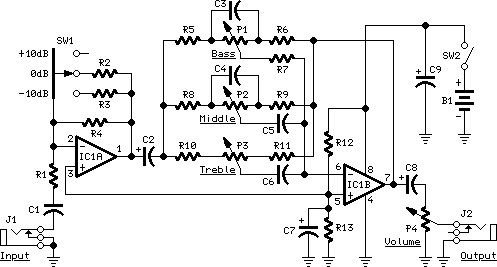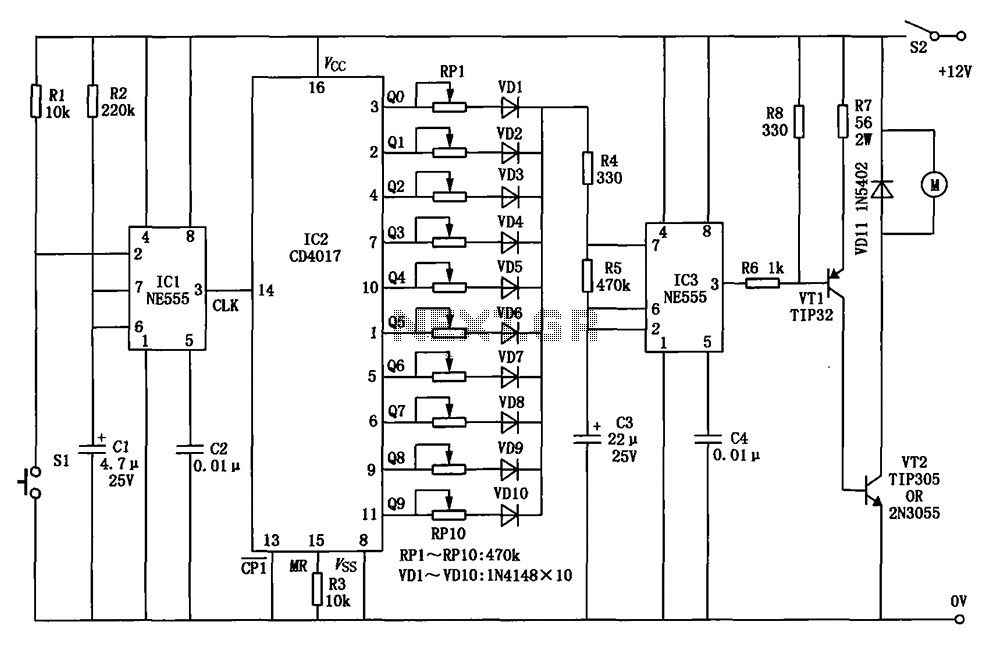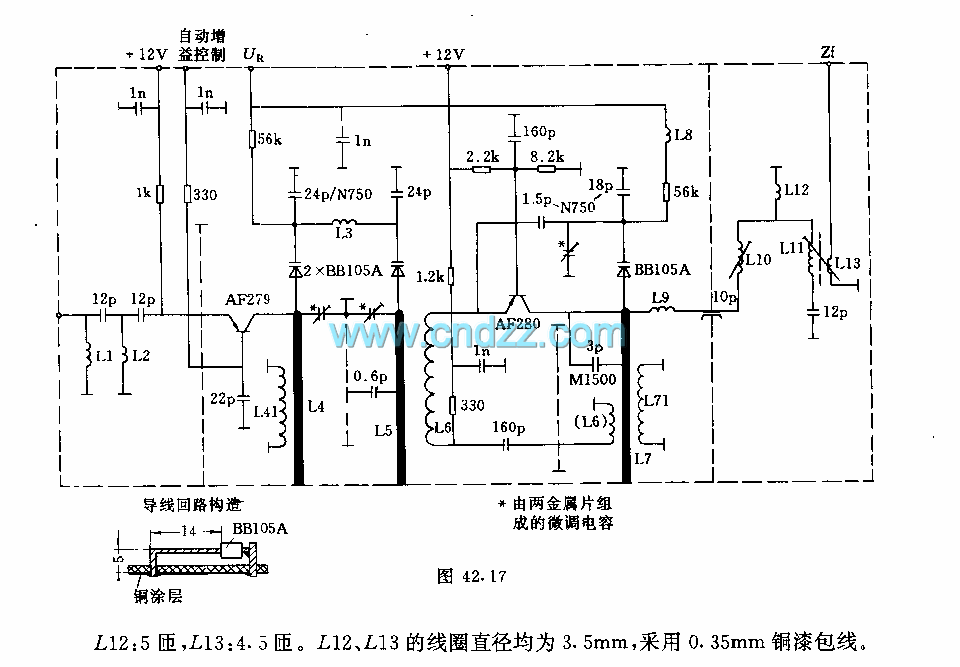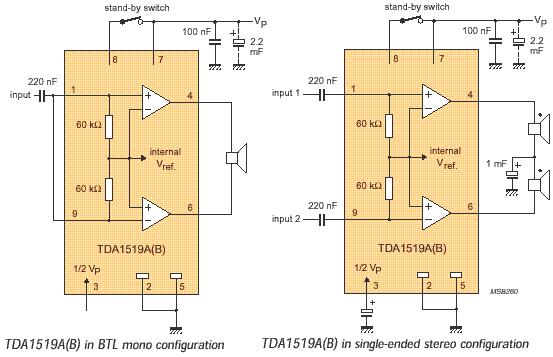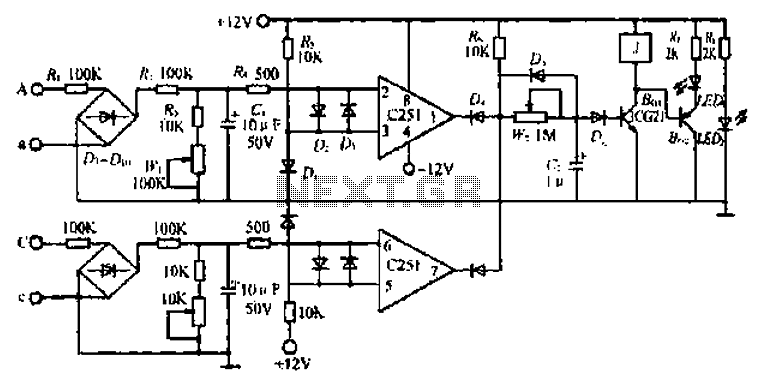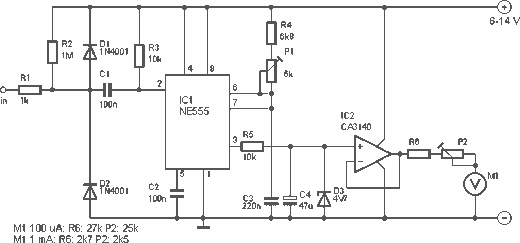
Fan automatic control circuit
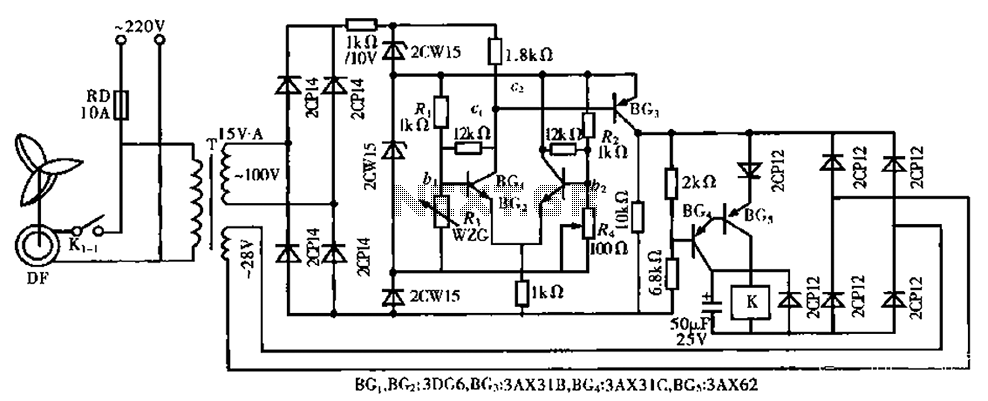
The circuit is a bistable circuit where each bistable unit is controlled by high and low output levels. When power is supplied to the circuit, current flows through components R13, CL, and VD to VD2 for full-wave rectification. The ZD and ZD2 act as secondary regulators, and VT1 provides electronic filtering to achieve an 8.5 V DC output. Due to the capacitance of C1, C3, and C6, which prevents voltage fluctuations, the IC pins 1, 5, and 11 remain low. Consequently, the inverter output terminals 6 and 10 are high, resulting in low outputs from the flip-flop circuit terminals 4, 8, and 12. This configuration causes transistors VT1, VT2, and VT4 to be turned off due to high base voltages, while VT3 is activated due to a low base voltage. As a result, VT3 conducts, but since VT4 is off, there is no collector current through VT3. Therefore, the thyristors VS1, VS2, and VS3 do not receive trigger currents and remain off, preventing the light L from illuminating and the motor M from operating. Meanwhile, capacitors C2, C4, and C6 charge through resistors R4 and R8, achieving approximately 8.5 V in about 0.1 seconds.
This bistable circuit operates as a memory element, maintaining its state until triggered to change by external control signals. The control mechanism relies on the high and low levels of the output, which govern the state of the circuit. The full-wave rectification process ensures that the input AC voltage is converted into a stable DC voltage, crucial for the reliable operation of the circuit.
The role of the ZD and ZD2 components as secondary regulators is to maintain a consistent output voltage despite variations in input voltage or load conditions. This regulation is essential for preventing damage to sensitive components within the circuit. The electronic filtering provided by VT1 helps to smooth out any ripples in the DC output, further ensuring stable operation.
The capacitors C1, C3, and C6 are integral in stabilizing the voltage across critical points in the circuit. Their ability to absorb and release energy mitigates voltage spikes that could otherwise disrupt the operation of the integrated circuit (IC) and the flip-flop outputs. The behavior of transistors VT1, VT2, VT4, and VT3 illustrates the importance of biasing in transistor operation, where the base-emitter voltage determines whether the transistor is in an on or off state.
The charging process of capacitors C2, C4, and C6 through resistors R4 and R8 is a critical aspect of timing within the circuit. The time constant, determined by the resistance and capacitance values, dictates how quickly these capacitors charge to the supply voltage. This charging period is essential for the proper timing of the circuit's response to control signals.
In summary, this bistable circuit is a well-designed system that utilizes various electronic components to achieve stable operation, effective voltage regulation, and reliable control over connected loads such as lights and motors. The interplay between capacitors, resistors, transistors, and thyristors illustrates fundamental principles of electronics, making this circuit a valuable example of practical circuit design. Box circuit) bistable circuit, each bistable circuit is a single bond by the control output high and low level. When the circuit instant access electricity, electricity through R13, cl, buck, VD, VD2 full-wave rectification, ZD, ZDz secondary regulator, then by VTs electronic filtering, got 8.V DC voltage. Because the capacitance C., C3, C, not the voltage across the energy mutation, so the IC, the input 1,5,11 pin is low, the corresponding inverter output terminal 6, 10 feet high, so each the output of flip-flop circuit terminal 4, 8, 12 feet low.
Thus, the transistor VT, VT2, VT4 base is extremely high, VT VT,, VT4 off, the VT3 base is extremely low, VT3 conduction. Because VT4 close, so VT3 no collector current, therefore, the thyristor vs, VS2, VS3 no trigger current is turned off, lights L is not lit, the motor M does not turn.
And the same time the capacitor C2, C4, C6 via a resistor feet, R4, Rg charged within about 0.1 8 can be charged to the supply voltage 8.5 V.
This bistable circuit operates as a memory element, maintaining its state until triggered to change by external control signals. The control mechanism relies on the high and low levels of the output, which govern the state of the circuit. The full-wave rectification process ensures that the input AC voltage is converted into a stable DC voltage, crucial for the reliable operation of the circuit.
The role of the ZD and ZD2 components as secondary regulators is to maintain a consistent output voltage despite variations in input voltage or load conditions. This regulation is essential for preventing damage to sensitive components within the circuit. The electronic filtering provided by VT1 helps to smooth out any ripples in the DC output, further ensuring stable operation.
The capacitors C1, C3, and C6 are integral in stabilizing the voltage across critical points in the circuit. Their ability to absorb and release energy mitigates voltage spikes that could otherwise disrupt the operation of the integrated circuit (IC) and the flip-flop outputs. The behavior of transistors VT1, VT2, VT4, and VT3 illustrates the importance of biasing in transistor operation, where the base-emitter voltage determines whether the transistor is in an on or off state.
The charging process of capacitors C2, C4, and C6 through resistors R4 and R8 is a critical aspect of timing within the circuit. The time constant, determined by the resistance and capacitance values, dictates how quickly these capacitors charge to the supply voltage. This charging period is essential for the proper timing of the circuit's response to control signals.
In summary, this bistable circuit is a well-designed system that utilizes various electronic components to achieve stable operation, effective voltage regulation, and reliable control over connected loads such as lights and motors. The interplay between capacitors, resistors, transistors, and thyristors illustrates fundamental principles of electronics, making this circuit a valuable example of practical circuit design. Box circuit) bistable circuit, each bistable circuit is a single bond by the control output high and low level. When the circuit instant access electricity, electricity through R13, cl, buck, VD, VD2 full-wave rectification, ZD, ZDz secondary regulator, then by VTs electronic filtering, got 8.V DC voltage. Because the capacitance C., C3, C, not the voltage across the energy mutation, so the IC, the input 1,5,11 pin is low, the corresponding inverter output terminal 6, 10 feet high, so each the output of flip-flop circuit terminal 4, 8, 12 feet low.
Thus, the transistor VT, VT2, VT4 base is extremely high, VT VT,, VT4 off, the VT3 base is extremely low, VT3 conduction. Because VT4 close, so VT3 no collector current, therefore, the thyristor vs, VS2, VS3 no trigger current is turned off, lights L is not lit, the motor M does not turn.
And the same time the capacitor C2, C4, C6 via a resistor feet, R4, Rg charged within about 0.1 8 can be charged to the supply voltage 8.5 V.
